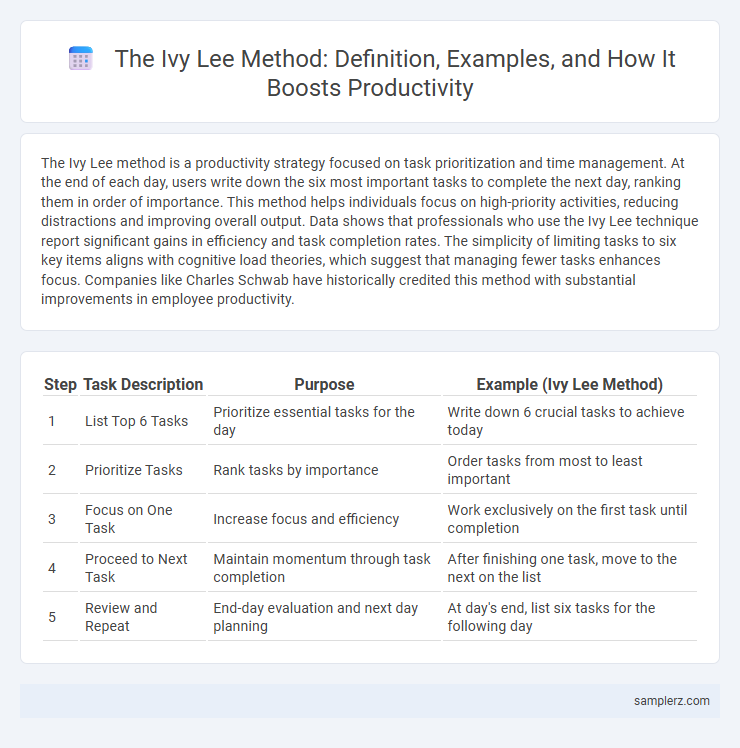The Ivy Lee method is a productivity strategy focused on task prioritization and time management. At the end of each day, users write down the six most important tasks to complete the next day, ranking them in order of importance. This method helps individuals focus on high-priority activities, reducing distractions and improving overall output. Data shows that professionals who use the Ivy Lee technique report significant gains in efficiency and task completion rates. The simplicity of limiting tasks to six key items aligns with cognitive load theories, which suggest that managing fewer tasks enhances focus. Companies like Charles Schwab have historically credited this method with substantial improvements in employee productivity.
Table of Comparison
| Step | Task Description | Purpose | Example (Ivy Lee Method) |
|---|---|---|---|
| 1 | List Top 6 Tasks | Prioritize essential tasks for the day | Write down 6 crucial tasks to achieve today |
| 2 | Prioritize Tasks | Rank tasks by importance | Order tasks from most to least important |
| 3 | Focus on One Task | Increase focus and efficiency | Work exclusively on the first task until completion |
| 4 | Proceed to Next Task | Maintain momentum through task completion | After finishing one task, move to the next on the list |
| 5 | Review and Repeat | End-day evaluation and next day planning | At day's end, list six tasks for the following day |
The Ivy Lee Method: Overview and Origins
The Ivy Lee Method, developed by productivity consultant Ivy Lee in 1918, involves writing down the six most important tasks for the next day and prioritizing them in order of importance. This simple yet effective technique boosts focus and efficiency by encouraging individuals to tackle one task at a time until completion. Its origins lie in Lee's work with Charles M. Schwab, who credited this method for significant productivity improvements in his company.
Step-by-Step Process of the Ivy Lee Technique
The Ivy Lee Technique involves writing down the six most important tasks for the next day, prioritizing them in order of true importance. Start each morning by focusing solely on the first task until completion before moving on to the next, ensuring maximum concentration and efficiency. This step-by-step process enhances productivity through structured task management and reduces decision fatigue.
Real-Life Example: Applying Ivy Lee to a Workday
Ivy Lee's method involves listing the six most important tasks to complete the next day and prioritizing them by importance, ensuring focused and efficient work. When applied to a workday, this technique reduces decision fatigue and increases productivity by directing attention to high-impact activities first. Employees report better time management and clearer priorities using Lee's simple yet powerful task prioritization strategy.
Prioritizing Tasks: Ivy Lee’s Influence on Productivity
Ivy Lee revolutionized productivity by introducing a simple prioritization method that involves listing six important tasks daily and ranking them by priority. This technique enhances focus by encouraging individuals to concentrate on one task at a time until completion, reducing multitasking and decision fatigue. Companies utilizing Lee's method report significant improvements in efficiency and task completion rates.
Case Study: Ivy Lee’s Method in Corporate Settings
Ivy Lee's Method, developed in 1918 for the Pennsylvania Railroad's executive team, demonstrates remarkable productivity enhancement by prioritizing six critical tasks daily in order of importance. This approach reduces decision fatigue and improves focus, resulting in higher task completion rates and streamlined workflows across corporate settings. Case studies reveal that companies implementing Lee's technique experience significant gains in employee efficiency and organizational output.
Sample Daily Task List Using Ivy Lee Approach
The Ivy Lee Method increases productivity by limiting daily tasks to six prioritized items, enhancing focus and reducing overwhelm. A sample daily task list includes writing a report, responding to key emails, preparing presentation slides, scheduling meetings, conducting market research, and reviewing project timelines. This structured approach helps maintain clear priorities and ensures consistent progress on critical work.
Ivy Lee’s Six-Task Principle: Practical Examples
Ivy Lee's Six-Task Principle enhances productivity by focusing on prioritizing and completing six critical tasks daily, reducing overwhelm and improving task management. For instance, by listing the six most important work assignments each evening and tackling them in order the next day, professionals experience increased focus and reduced procrastination. This method is proven to streamline workflows and elevate efficiency across various industries.
Transforming Workflow with the Ivy Lee Method
The Ivy Lee Method revolutionizes workflow by limiting tasks to six critical items per day, prioritizing clarity and focus. By encouraging workers to concentrate on one task until completion, it enhances productivity and reduces mental clutter. This time-tested technique promotes sustained work momentum and significantly improves task management efficiency.
Comparing Ivy Lee’s Technique With Other Task Methods
Ivy Lee's technique emphasizes prioritizing the six most important tasks daily, which contrasts with the Eisenhower Matrix that categorizes tasks by urgency and importance for decision-making. Unlike the Pomodoro Technique's focus on timed intervals for work and breaks, Lee's method streamlines productivity by concentrating solely on task order and completion. Research indicates that Ivy Lee's system improves focus and reduces overwhelm by simplifying task lists, promoting task completion efficiency over multitasking-based strategies.
Success Stories: Ivy Lee’s Task Strategy in Action
Ivy Lee revolutionized productivity by introducing a simple yet powerful task prioritization method that helped executives focus on six important tasks daily, resulting in remarkable efficiency improvements. This strategy, later adopted by leaders like Charles M. Schwab, demonstrated how clear prioritization and disciplined focus drive substantial business success. Lee's method remains a cornerstone example in productivity studies, proving that structured task management directly enhances performance outcomes.

example of ivy lee in task Infographic
 samplerz.com
samplerz.com